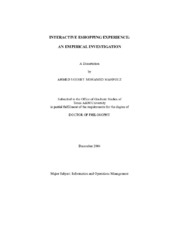| dc.description.abstract | Utilizing an experimental design, the study investigates the effects of eshopping behavior (experiential, utilitarian, or mixed) and interactivity level (low or high) on the consequences of eshopping (site attitude and future purchase intentions), as mediated by eshopping experience (sensory, affective, and cognitive) and flow experience (control, attention focus, and cognitive enjoyment).
Structural equation modeling was used for data analysis. Eshopping behavior had a weak negative effect, and interactivity level had a weak positive effect, on eshopping experience. Experiential eshopping behavior decreased eshopping experience more than mixed or utilitarian eshopping behavior did. The latter two behaviors were not significantly different from each other in terms of eshopping experience. High interactivity level web sites increased eshopping experience more than low interactivity level sites did. Interactivity level had a weak negative effect on flow's control dimension and a moderate positive effect on flow's cognitive enjoyment component. High interactivity level sites moderately increased cognitive enjoyment more than low interactivity level sites did. Eshopping experience strongly and positively influenced flow experience in terms of control and cognitive enjoyment, and moderately impacted attention focus. Cognitive enjoyment had a strong positive effect on site attitude and future purchase intentions. However, control and attention focus did not significantly affect future purchase intentions. The study found an indirect effect of eshopping behavior on site attitude, instead of the traditional effect of attitude on behavior based on the theory of reasoned action and technology acceptance model. The results of the pilot study (N = 105) were consistent with the final study (N = 310).
The study attempts to add to the small base of existing studies that examine eshopping experience and flow theory in an ecommerce setting (Novak et al. 2003; Skadberg and Kimmel 2004). The present study contributes to the online consumer behavior literature by utilizing flow theory and investigating the mediating effects of eshopping experience and flow experience on the consequences of eshopping. The findings should help inform web site design, facilitating the creation of sites which are more responsive to users by providing interactive features and understanding eshopping behaviors which users exhibit. | en |


